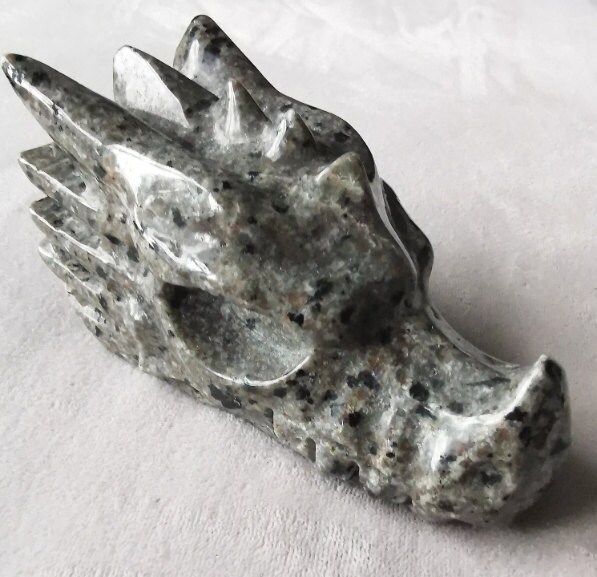Yooperlite was discovered in 2017 by Erik Rintamaki, a Michigan-based rock collector and enthusiast. He made the discovery while searching along the shores of Lake Superior using a UV flashlight. When illuminated by ultraviolet (UV) light, these otherwise dull-gray rocks glow with an intense, fiery orange hue. This mesmerizing effect was unlike anything he had seen before, prompting further investigation.Rintamaki named the stone "Yooperlite," combining "Yooper," a term referring to residents of Michigan’s Upper Peninsula (or the "U.P."), and "lite" from "rock" or "mineral." This discovery gained widespread attention among rockhounds and geologists, as it was a completely new finding for the region.
Despite its recent discovery, scientists were able to determine that Yooperlite is actually a type of syenite rock that contains fluorescent sodalite. Sodalite is a mineral known for its blue hue, but in this case, it is invisible in natural light. However, under UV light, the sodalite content causes the rock to emit a bright orange or yellow glow.Yooperlite is a product of ancient geological processes. It is believed that these rocks were originally formed through volcanic activity and later transported to the Upper Peninsula by glaciers during the Ice Age. This glacial movement is responsible for the abundance of unique stones and minerals along the shores of the Great Lakes.
The primary location for finding Yooperlite is the Upper Peninsula of Michigan, particularly along the shores of Lake Superior. However, the presence of these glowing rocks has also been reported in other parts of the Great Lakes region and beyond. Rock hunters searching for Yooperlite often venture out at night with UV flashlights to spot the glowing stones along the lake’s shoreline.
Since its discovery, Yooperlite has become a highly sought-after mineral among rock collectors and hobbyists. Its unique fluorescent property makes it one of the most visually striking stones to add to any collection. The excitement of searching for Yooperlite has also contributed to a surge in tourism to Michigan’s Upper Peninsula, with many visitors eager to experience the thrill of discovering glowing rocks firsthand.In addition to being popular among collectors, Yooperlite is also used in jewelry and decorative items. Many artisans incorporate the stone into necklaces, bracelets, and other ornamental pieces, particularly because of its unique ability to glow under UV light.
From a geological perspective, the discovery of Yooperlite has provided scientists with new insights into the mineral composition of the Great Lakes region. The identification of sodalite-rich syenite in Michigan adds to our understanding of glacial movements and the transportation of rocks across vast distances.Additionally, Yooperlite’s fluorescence under UV light has intrigued researchers studying luminescence in minerals. By analyzing how different minerals react to ultraviolet light, scientists can gain a better understanding of the geological history of various regions and the conditions under which these minerals formed.
Beyond its scientific and aesthetic appeal, Yooperlite is also believed to possess various metaphysical and healing properties. Many crystal enthusiasts and spiritual practitioners consider it a powerful stone for emotional healing and self-discovery.
Enhancing Communication: It is said that Yooperlite can help individuals express their thoughts and emotions more clearly. This makes it particularly beneficial for those who struggle with communication or have difficulty voicing their feelings.
Emotional Healing: Some believe that Yooperlite has a calming effect, helping to alleviate stress, anxiety, and negative emotions. It is often used in meditation to bring inner peace and clarity.
Boosting Creativity: Many artists and creative individuals are drawn to Yooperlite due to its association with inspiration and innovation. Holding or working with the stone is thought to stimulate new ideas and encourage creative expression.
Chakra Alignment: In spiritual practices, Yooperlite is associated with the throat chakra, which governs communication and self-expression. By balancing this chakra, individuals may find it easier to speak their truth and connect with others more effectively.
While these claims are based on personal experiences and beliefs rather than scientific evidence, they add to the mystique and allure of Yooperlite.
For those interested in finding Yooperlite, the best time to search is at night along the shores of Lake Superior. A high-quality UV flashlight is essential, as it reveals the stone’s glowing properties in the dark. The ideal conditions for searching include clear skies and low light pollution, which make it easier to spot the fluorescent glow.When identifying Yooperlite, look for:
- A dull gray or brownish exterior in normal light
- An intense orange or yellow glow under UV light
- A rough, grainy texture similar to other syenite rocks
If you’re new to rock hunting, guided tours and workshops are available in Michigan’s Upper Peninsula to help enthusiasts learn proper techniques for finding and identifying Yooperlite.


